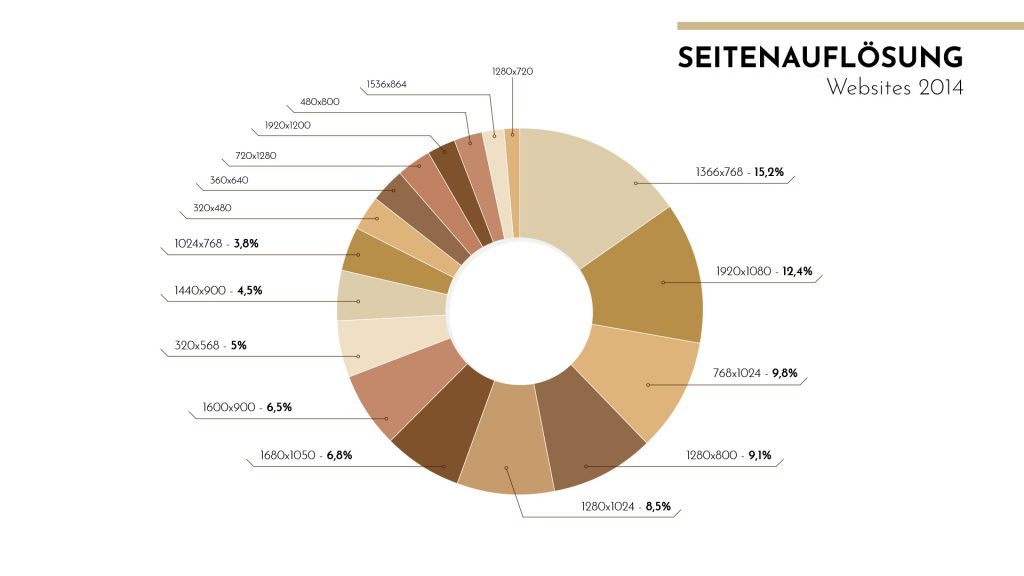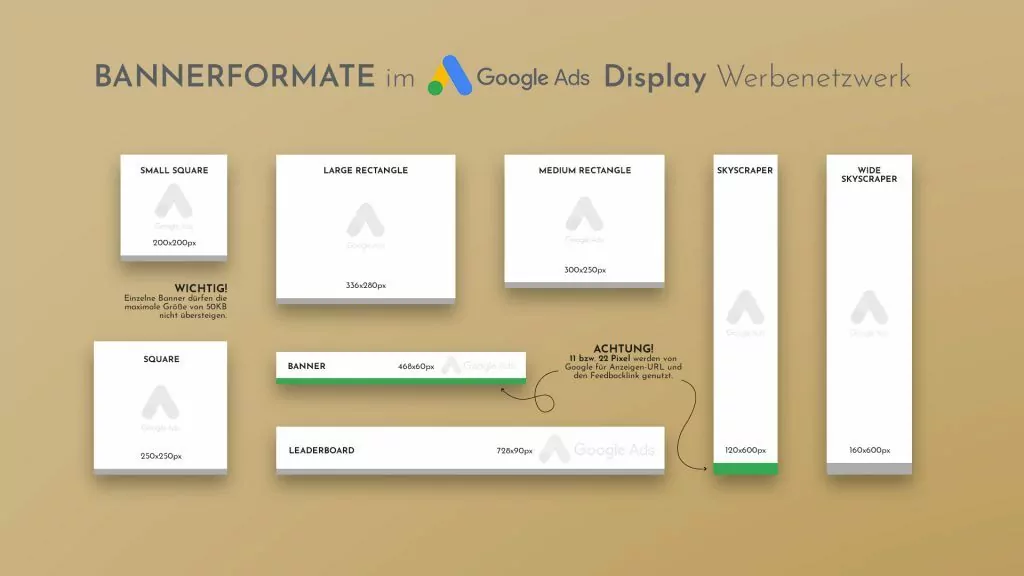How to use Google Ads banners correctly

With Google Ads, you can place different ads in a huge advertising network that has proven its potential time and again. In addition to search and shopping ads, you can also use display ads, which we will take a closer look at below.
Display ad formats are often used in affiliate marketing and are delivered under certain advertising guidelines in Google's advertising network. The banners can be customized for all end-user devices (desktop and mobile), which gives them a significant advantage over static ads. In addition to fixed text banners, the placement of animated banners is also possible.
Once you decide to use Google Ads banners, it is advisable to filter out the most effective ad options and formats for your business. In this regard, we explain the following aspects:
Which formats are relevant?
With banner advertising through Google Ads, you present your company, a product or a brand on thematically related pages as well as on websites visited by your target group. Various targeting options and banner formats help you tailor your offer specifically to target groups, devices, and pages.
Basically, the Google Ad Banner choice is fixed to a certain selection. This is predefined in shape, size ratio and (partial) positioning. Furthermore, you have to decide whether you want to place image ads or animated banners.
The following graphic shows which banner formats are available:

Permitted banner sizes (source: adseed.de)
In addition, special formats allow you to choose other representations:
- Large rectangle: 336 x 280 pixels
- Inline rectangle: 300 x 250 pixel
- Half-page: 300 x 600 pixel
- Large leaderboard: 970×90 pixels
- Large mobile banner: 320 x 100 pixel
- Billboard: 970 x 250 Pixel
- Portrait: 300 x 1050 Pixel
The choice of banner size or format depends on several targeting factors.
Example: While large-format ads can have an appropriate impact on desktops and laptops, smaller banners are suitable for page displays on mobile devices and in apps. Aspects such as browser, operating system, and cultural group are also relevant.
The most important formats for remarketing banners, which from our experience work particularly well in German-speaking countries, are compiled in the following list (data always in pixels and for 72 dpi):
300 x 250 pixels: This format is suitable if you only want to create a single banner.
320 x 50 pixels: This is a suitable format for mobile advertising, which is also used in apps.
728 x 90 pixels: Our experience reflects study results (LINK to GDN Case-Study possible) that this format works especially well in combination with 300 x 250 pixel banners when 2 banners are to be placed.
468 x 60 pixels: This format is popular on older websites. However, the usage rate is steadily decreasing.
If you are looking for opportunities to become in other European countries, Google Ad banner formats offer you the option to display a product-relevant content in a target group-oriented way. We have selected four countries as examples where specific banner formats are effective:
- Poland: 750 x 100, 750 x 200, 750 x 300 pixels
- Russia: 240 x 400 Pixel
- Sweden: 250 x 360, 980 x 120 pixel
- Norway: 580 x 400 Pixel
One of the most common questions when choosing banner formats is which one is the most effective. The answer is mainly based on three sizes:
- Campaign objective (What is to be achieved?)
- the targeting factors (e.g. technical requirements, bandwidths, frequency of display, geo/regio targeting, end-user devices incl. operating system, user and environment targeting, etc.)
- Campaign budget.
Last but not least, you need to clarify on which pages a Google Ads banner should be placed. On your own pages, there is hardly any limit to the selection. If external site operators are involved, they usually specify banner positions and banner sizes.
A clear objective determines the type of banner
What do you want to achieve with the banner and when(!) should it catch the visitor's eye? If it is important to you to generate attention and to direct the user to your offer already at the beginning of his website visit, the placement of a Google Ads banner in the header of a page can make sense.
If your concern is to inform FIRST and to place the offer FINALLY, a place outside the header should be chosen accordingly.
Let's go specifically into some examples:
Leaderboard banners (728 x 90 pixels) are ideal if you want your banner to be visible to the user immediately above the fold when a page is called up . This area can be viewed without scrolling and is the most unifying from a conversion point of view. For this reason, we advise filling this area of a website exclusively with relevant content. In the majority of our campaigns, we find that in many cases users do not scroll, but decide with their first glance whether to stay on a page.
If your concern is to advertise primarily on mobile devices, Google Ads banners in the formats 320 x 50 or 300 x 250 pixels are recommended. Another advantage of this is the budget to be calculated: If you decide on an advertising option promptly, the graphic designer does not have to generate corresponding advertising for each format. This saves financial resources that can be allocated according to the reach and advertising frequency.
Depending on how widely dispersed a target group is, it can make sense to set up a campaign broadly. The more banner formats you use, the more often and on the more pages they will be displayed to your potential customers. But here, too, effectiveness beats efficiency: you should use the right banners, rather than using all the banners correctly. It's important to avoid wastage, so that when you evaluate your campaign, you can determine all the more precisely which formats will be effective in the future and why others won't lead to the desired conversion.
These formats achieve the most reach
Our experience and evaluations of customer reports show that regardless of the file format used for Google Ads banners (whether image ads or animated .GIF), the same formats are always the most effective.
If, as with a placement campaign, the focus is on generating maximum reach, the following formats are most effective:
Banners in the formats 320 x 50, 728 x 90, 300 x 250, 160 x 600 and 468 x 60 pixels receive the most impressions (number of times the banner appears on a page). Only one of them (320 x 50) is specifically designed for mobile devices, so we can fully recommend the other four formats for generating reach. The 320 x 50 format can be used in an additional campaign for mobile devices if this fits the campaign strategy.
Please keep in mind that banners in apps are not infrequently clicked on "by accident", resulting in an increased impression rate. For branding campaigns, this can be beneficial. For conversion-oriented campaigns, this is disadvantageous, since it cannot be specifically recorded why the user does not also "take the last step" (i.e. contact or purchase).
How do these results come about?
The high reach of the format for mobile devices should come as no surprise; after all, more people have been accessing the Internet with a mobile device than with a desktop PC since the end of 2016.
But the high reach of the other formats can also be explained: It's a matter of which browsers are most popular and which aspect ratios and resolutions are most likely to be used.
Tips for successful ads
Building Google Ad banners for relevant pages
The majority of advertising-relevant pages implement Google Ads banners via AdSense and present content in the dimension of 900 to 1300 pixels wide.
The advertising areas are structured as follows: At the top or bottom is the header or footer area, where the banners in the formats 468 x 60 and 728 x 90 pixels are used. In the navigation area to the left or right of the main content or the sidebar, experience has shown that the formats 300 x 250 or 160 x 600 pixels are often used.
Once you've decided whether you'd rather appear immediately at the top of the page, or perhaps you'd prefer to present yourself in the sidebar for a longer period of time. We recommend rather animations for header and footer; static banners are suitable for sidebars or generally page sections that are in the field of vision for a longer time.
Tip: Display Ad Builder
With the Display Ad Builder, Google's AdWords system offers a tool for the quick and (relatively) easy creation of image ads. With just a few clicks, you can choose from various banner templates in different categories and create an individualized banner.
The tool is suitable for those who want to be self-taught. An image ad in the corporate design to match your website not only enhances the banner itself. It creates a recognition value, which experience has shown to have a positive effect on user behavior. Furthermore, the image ads from the Ad Builder offer a good opportunity to check whether the chosen formats are appealing or even offer an alternative to self-designed ads.
Google's guidelines for advertising banners
Content placed via Google Ads, for example, must be adult content and may not exceed a file size of 150 kb. The only allowed file types are .JPEG, . JPG, .PNG and .GIF. Additionally, for mobile image ads, the landing page code must be programmed for mobile devices.
Animated banners in .GIF format must not exceed an animation duration of 30 seconds. In addition, a maximum speed of 5 FPS (frames per second) is required. If the animations are looped, they must still stop after 30 seconds.
Under certain circumstances, banners can also be rejected:
- inadequate quality of the image
- Violent flashing (stroboscopic effect)
- Simulated mouse or computer actions
- Trick-to-click
However, those who consistently follow these exclusions will find themselves on the safe side and will most likely be displayed.

Google Ads banners - keep an eye on current developments
To benefit from Google Ads banners and image ads permanently, you should maintain them and adapt them to new conditions. Over the coming months and years, worthwhile formats will change as new technologies come onto the market such as new smartphone or tablet formats. The usage behavior of a target group may also change, making new banner formats necessary. In addition, annual trends can be observed that affect graphic designs, typography and image elements. This means that banner images become outdated and must be updated and adapted in order to have a lasting effect.






